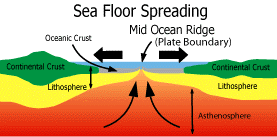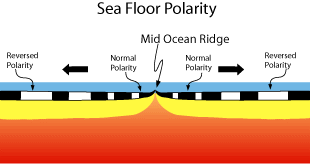SEA FLOOR SPREADING
The Mid Atlantic ridge neatly divides the
Atlantic Ocean into two equal halves, and the geography of  the
ridge is almost exactly parallel to the coastlines of Africa and South America
as well as Europe and North America. Additionally, the age distribution of
the ocean floor is symmetrical along the axis of the ridge. The youngest rocks
on the floor of the Atlantic are at the mid ocean ridge. In fact, the mid-ocean
ridges are the site of active volcanic eruptions. The oceanic rocks become older
on either side of the ridge, increasing in age to a maximum of approximately 175
million years in the North Atlantic near the coasts of Europe and North America.
the
ridge is almost exactly parallel to the coastlines of Africa and South America
as well as Europe and North America. Additionally, the age distribution of
the ocean floor is symmetrical along the axis of the ridge. The youngest rocks
on the floor of the Atlantic are at the mid ocean ridge. In fact, the mid-ocean
ridges are the site of active volcanic eruptions. The oceanic rocks become older
on either side of the ridge, increasing in age to a maximum of approximately 175
million years in the North Atlantic near the coasts of Europe and North America.

MAGNETIC ANOMALIES AND THE AGE OF THE EARTH
For hundreds of years, since people began using compasses, we have relied on
them to point North. However, a million years ago, compasses would have pointed South; before that, North, and so on, because the earth's magnetic
field flips its direction from time to time. It does not flip at regular
intervals. For example, the field was "normal" (the same direction as
now) for 200,000 years, "reversed" (the opposite direction from now)
for 300,000 years, normal for 50,000 years, reversed for 190,000 years, and has
now been normal for 730,000 years. These reversals are recorded in rocks that
contain iron (particularly basaltic volcanic rocks, because when the volcanic
flows cool, the iron contained within them is aligned parallel to the prevailing
magnetic field at that time). This means that basalts which erupted at the
midocean ridges preserve the record of magnetic field reversals; rocks that
cooled under "normal" magnetic fields are normally polarized and rocks
that cooled under "reversed" conditions are reversely polarized. As
the hot basalt emerges from the ridge, it is pushed away from the ridge in both
directions by more emerging basalt. This pushing out to both sides causes
magnetic "stripes", or anomalies, that are symmetrical about the
ridges. Because the reversal pattern is irregular, but the same all over the
world, it can be used like tree rings to date rocks by examining the pattern of
magnetization that they preserve. This "magnetostratigraphy" has been
verified by direct sampling of sea floor rocks and age determinations.
have pointed South; before that, North, and so on, because the earth's magnetic
field flips its direction from time to time. It does not flip at regular
intervals. For example, the field was "normal" (the same direction as
now) for 200,000 years, "reversed" (the opposite direction from now)
for 300,000 years, normal for 50,000 years, reversed for 190,000 years, and has
now been normal for 730,000 years. These reversals are recorded in rocks that
contain iron (particularly basaltic volcanic rocks, because when the volcanic
flows cool, the iron contained within them is aligned parallel to the prevailing
magnetic field at that time). This means that basalts which erupted at the
midocean ridges preserve the record of magnetic field reversals; rocks that
cooled under "normal" magnetic fields are normally polarized and rocks
that cooled under "reversed" conditions are reversely polarized. As
the hot basalt emerges from the ridge, it is pushed away from the ridge in both
directions by more emerging basalt. This pushing out to both sides causes
magnetic "stripes", or anomalies, that are symmetrical about the
ridges. Because the reversal pattern is irregular, but the same all over the
world, it can be used like tree rings to date rocks by examining the pattern of
magnetization that they preserve. This "magnetostratigraphy" has been
verified by direct sampling of sea floor rocks and age determinations.
 the
ridge is almost exactly parallel to the coastlines of Africa and South America
as well as Europe and North America. Additionally, the age distribution of
the ocean floor is symmetrical along the axis of the ridge. The youngest rocks
on the floor of the Atlantic are at the mid ocean ridge. In fact, the mid-ocean
ridges are the site of active volcanic eruptions. The oceanic rocks become older
on either side of the ridge, increasing in age to a maximum of approximately 175
million years in the North Atlantic near the coasts of Europe and North America.
the
ridge is almost exactly parallel to the coastlines of Africa and South America
as well as Europe and North America. Additionally, the age distribution of
the ocean floor is symmetrical along the axis of the ridge. The youngest rocks
on the floor of the Atlantic are at the mid ocean ridge. In fact, the mid-ocean
ridges are the site of active volcanic eruptions. The oceanic rocks become older
on either side of the ridge, increasing in age to a maximum of approximately 175
million years in the North Atlantic near the coasts of Europe and North America.

